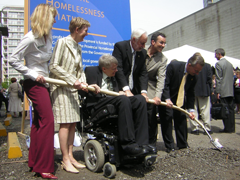
Mayoral candidate Peter Ladner claims Vancouver will gain 3,813 non-market social housing units in the five-year period from 2005 -- when his Non-Partisan Association returned to power -- through 2010.
Downtown Eastside activist David Eby claims the city has lost 1,448 low-income hotel rooms from July 2003 -- when the Olympics were awarded -- through March 2008.
Both claims are interpretations of facts. Neither tells the whole story.
And this widening canyon between the way the NPA-led city hall perceives its accomplishments and the way frontline workers see the problem points to a problem buried within Vancouver's homelessness crisis: Until politicians and street-level social workers can agree on the scope of the problem, the odds of agreeing on solutions remain slim.
NPA claim mirrors homeless plan target
Ladner's claim is stated at the top of the seventh page of the NPA's "Action Plan For Vancouver," which was released on Oct. 16.
In a section entitled, "Our Record -- Some of Our Accomplishments to Date," the NPA plan asserts that the NPA team "Partnered with provincial government to construct, convert or develop 3,813 units of non-market and supportive housing, including 2,461 new units between 2005-2010."
Ladner has repeated that claim -- often without the careful qualifying language -- in campaign appearances and debates. Likewise, he has repeatedly expressed his belief that the city's June 2005 Homeless Action Plan will solve the city's homeless problem.
The number 3,800 is significant because it also happens to be the target number of supportive housing units called for by the city's Homeless Action Plan. Thus, by asserting both that the city has already created 3,800 units and that the city plan is sufficient, Ladner has subtly laid the groundwork to declare victory over homelessness.
Memo written in response to Tyee report
The NPA's number was drawn from a Sept. 11, 2008 memo authored by Dan Garrison, a planner in the city's Housing Centre.
Garrison's memo was written in response to a June 2007 Tyee report entitled, "Province's Boasts of 'New' Homeless Units Don't Add Up."
Garrison tallied up every non-market housing project that had changed status since the beginning of 2005 and concluded: "From 2005 to the end of 2010, 3,813 units will be added to the non-market housing stock. Of these units, 2,461 are new construction and 1,352 are conversions from private rental market."
Garrison's claim was somewhat more limited than the NPA's subsequent boast, in that he made no effort to identify which civic political party was responsible for which units. The memo included an appendix that lists each project included in his claim.
The Tyee cross-referenced Garrison's memo with earlier city memos detailing each of the projects listed in Garrison's appendix.
After subtracting projects that were either not new (as noted), not the work of the NPA (as claimed by the party), or that are unlikely to be completed by 2010 (as claimed by both Garrison and the NPA), The Tyee was able to identify only two projects remaining, with a combined total of only 117 units.
Whittling down the NPA claim
Not new: Garrison's memo and the NPA platform both acknowledge that 1,352 of the 3,813 alleged housing units are not new construction but are units that are being "converted" from non-market seniors housing, market rental apartments, and the 16 residential hotels purchased by BC Housing.
"I didn't say they were all new units," Ladner acknowledged during questioning in last week's homelessness debate. But when he raised the issue, he initially cited only the "3,800 units" figure. Likewise, on the campaign trail and in previous debates, Ladner has claimed the "3,800 unit" number without qualification. That's the number most voters hear; that's the number that has been cited in media reports.
Not NPA: Another 913 of the 3,813 units on Garrison's list were developed and fully funded before the NPA took control in November 2005, according to city memos detailing those projects. These include both the Woodwards redevelopment and the Olympic Village at South East False Creek, where the NPA trimmed social housing.
"Every council benefits from the work of previous councils," Ladner replied when challenged on this point. "I'm not saying the NPA built these buildings."
Not by 2010: Another 1,471 units on Garrison's list have yet to break ground. Development approvals have been granted for seven BC Housing projects, and approvals for two more are anticipated in November. Construction could begin early next year, but the city expects it will take two to three years before those units will be in place.
"We've zoned for eight of them now. The rest will be zoned very shortly," Ladner replied. "The fence has gone up around 7th and Fir."
3,813 units; one groundbreaking
The Tyee's review of Garrison's list did identify two non-market housing projects for which the current NPA-led city council can unabashedly claim credit: The creation of 30 transition units above the Insite supervised injection site, and the re-launch of Kindred Place at 1321 Richards St.
Mayor Sam Sullivan brought a large, custom-made shovel to the Kindred Place groundbreaking (pictured above). Sullivan promised to carve a notch in that oversized handle each time he broke ground for another new social housing project.
Sam's big shovel has yet to reappear.
In a one-on-one conversation with Coun. Ladner immediately following that 2007 groundbreaking, The Tyee expressed concern about Mayor Sullivan's exaggerated housing claims. Ladner agreed that some of Sullivan's claims merited examination, but (correctly) argued that the Kindred Place apartments were new units.
Now candidate Ladner claims his party has created 3,813 units of housing by 2010, in spite of having thus far broken ground for only one new building.
More units lost than gained?
Pivot Legal Society lawyer David Eby, like other activists working in the Downtown Eastside, counts housing in a whole different way.
"There's only one question that matters to the homeless," Eby said. "How many rooms are available at the $375-a-month welfare rate?"
The answer? Close to zero, according to recent surveys by Pivot and the Carnegie Community Action Project.
Those studies find that the losses of aging hotel rooms to modernization and redevelopment have significantly outpaced the additions of new social housing units, and that few of the remaining rooms are being offered at the provincial welfare rate.
An ongoing Pivot study identifies 1,448 rooms in residential hotels -- often dubbed single-room-occupancy or SRO hotels -- that have been closed since the 2010 Winter Games were awarded in July of 2003.
The Pivot tally does not take into account the renovation of nearly a thousand SRO rooms purchased by the province.
"Those SROs were fully occupied with people at risk of homelessness," Eby explained. "Several are currently closed for renovations. When they reopen, those SROs are expected to contain fewer rooms -- with fewer beds -- than they offered before."
Compounding that number, the Carnegie team reports that fewer and fewer of the remaining privately owned rooms are available at welfare rates. The Columbia Hotel, for example, now charges more than $800 a month for a room.
"Anyone who's lived down here for the last few years will tell you the same thing," Carnegie's Jean Swanson said. "There are far fewer rooms for rent today then there were three years ago."
Rate of added housing 'significantly short of target'
On one point, both the NPA and its critics agree: Vancouver is doing more to help its homeless than any other Lower Mainland municipality. But how much is B.C.'s largest city really accomplishing?
Among the most even-handed assessments of the city's progress toward creating homeless housing can be found in a July 2008 report on progress toward the city's Homeless Action Plan.
"From 2005 to 2008, a total of 458 new units of supportive and transitional housing have been created in the city, and average of 150 units per year over the past three years," stated that memo, also authored by Dan Garrison. "The addition of 150 supportive and transitional housing units per year since 2005 reflects action in the right direction, but falls significantly short of the HAP target of 380 units per year."
A Carnegie tally of planned units similarly estimated Vancouver's completion rate at about 100 new units per year.
"Replacing 4,000 SRO rooms at this rate would take up to 40 years," Swanson said, "and still wouldn't provide housing for the thousands of people already living on Vancouver streets."
Pivot's Eby questioned the logic of Sullivan and Ladner in claiming the city is on target for meeting its social housing needs.
"It doesn't make any sense to me why the NPA continues to make these exaggerated housing claims," said Eby, who unsuccessfully sought a spot on opposition party Vision Vancouver's council slate. "How do these claims help the city impress senior governments on the need for more funding?"
"If I were a councillor," Eby added with a chuckle, "I'd make darned sure that every unit was new, fully funded and under construction before counting it."
Related Tyee stories:
- Seven Solutions to Homelessness
Each is working somewhere else, and will save money and lives here. - Homeless in Suburbia
Why shelters outside of Vancouver are filling up. - BC's Homeless Death Toll: 56 or More in Two Years
Tally of homeless deaths released to Tyee by chief coroner.
















Tyee Commenting Guidelines
Comments that violate guidelines risk being deleted, and violations may result in a temporary or permanent user ban. Maintain the spirit of good conversation to stay in the discussion.
*Please note The Tyee is not a forum for spreading misinformation about COVID-19, denying its existence or minimizing its risk to public health.
Do:
Do not: